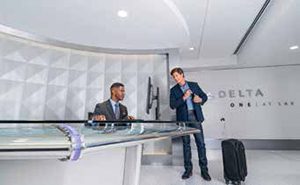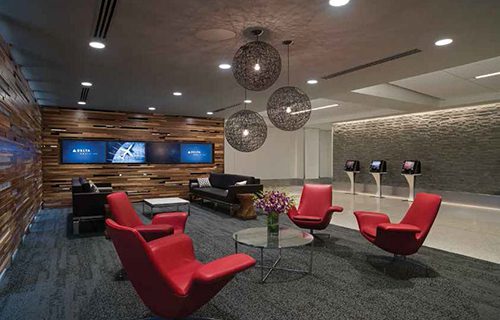The $229 million renovation of Terminal 5 in Los Angeles International Airport (LAX) wrapped up this summer on time and on budget, with optimism high about how it will enhance the travel experience for about 6.6 million domestic passengers who use the facility each year. With Delta Air Lines as the terminal’s sole airline tenant, the initiative was cooperatively funded by Delta ($11.2 million to renovate its proprietary areas and equipment), a TSA grant ($25 million for inline baggage screening) and nearly $193 million by Los Angeles World Airports (LAWA), which owns and operates LAX, Los Angeles Ontario International and Van Nuys Airport.
The Terminal 5 overhaul is just a portion of an $8 billion improvement program that spans the entire airport. LAWA is undertaking the massive initiative to “transform and modernize LAX into a facility befitting the hundreds of thousands of people who fly in and out of our region each day,” says Roger Johnson, director of LAWA’s Airports Development Group.
Renovations in Terminal 5 were specifically designed to develop a guest experience that truly caters to the modern traveler. “These upgrades are transforming millions of visitors’ first and last impressions of Los Angeles,” Johnson notes.
| factsfigures Project: Terminal Redevelopment Location: Los Angeles Int’l Airport Terminal: 5 Cost: $229 million Owner: Delta Air Lines & Los Angeles World Airports Program Duration: 60 months Project Management: PM Technologies Architecture & Design: Corgan Prime Construction Contractor: Swinerton Builders Structural Engineer: Beuhler & Beuhler Mechanical/Electric/Plumbing: PBS Engineers Passenger Boarding Bridges: JBT AeroTech Boarding Bridge Design/Installation: AERO BridgeWorks, Inc. Baggage Handling & Security Screening Systems: Siemens Skyclub Upgrades: Nextstep Design; IA; Clark Construction Primary Elements: Aesthetic enhancements; improved layout; Delta ONE lounge & upgraded Sky Club; expanded Customs & Border Protection facility; new outbound baggage handling system; expanded security checkpoint queuing; new passenger boarding bridges; renovated ticketing lobby; new HVAC system; seismic enhancements; restroom renovations; new elevators & escalators Key Benefits: Improved passenger experience; refreshed appearance; additional service benefits for premium passengers |
Jacobus Claassens, Delta’s regional director, notes that the recently completed project was necessary mainly to update the facility. The terminal’s last renovation was in 1986, with smaller updates following, but “nothing big enough that would upgrade the building,” he relates.
“We wanted to really enhance the customer experience while supporting the significant growth that we’ve had (in flights and passengers) since 2011,” Claassens explains.
In 2008, various consultants surveyed the building and its systems to help determine what would need to be replaced and/or upgraded. Planners and architects used the results of a facility assessment study and modeling studies to increase the terminal’s processing capabilities and improve its building systems and aesthetic properties.
Improving Passenger Flow
Construction on the 140,000-square-foot terminal began in 2011. Upgrades focused on supporting the reliability of Delta’s operations, increasing the efficiency of passenger and baggage processing and improving the overall passenger experience, details Claassens.
Without adding square footage to the terminal, architects managed to double the size of the ticketing lobby. Personnel from architect of record Corgan explain that the terminal’s new design reconfigured the available square footage in a way that accommodates a more efficient ticketing process. Instead of a traditional linear check-in process, Terminal 5 now features a pod concept, which allows for different levels of service and processes customers much more quickly, details Corgan principal Jeff Mangels. The newly configured lobby features 40 ticket counter locations and 39 self-service kiosks.
The airport recaptured a significant amount of space by using the alternative approach, notes Charles Henning, AIA, program design executive with project management firm PM Technologies. The reclaimed space is used for additional queuing areas in the ticket hall and security checkpoint. The new allocation and orientation of space provides more intuitive wayfinding and a more open feel – particularly in the atrium, Henning specifies.
Additional efficiencies were gained by expanding the TSA checkpoint from seven lanes in one location to nine lanes in two separate areas. The new system helps passengers get to their gate in a more timely manner, reports Claassens.
Increasing the queuing depth of the security checkpoint required structural modifications. Before the changes, lines of Delta customers waiting to clear Security often extended out onto the sidewalk, Mangels recalls. “Increasing that queuing area was important to increasing that level of service,” he notes.
On the arrivals level, the new design considerably opens up the area out to the curbside. The change not only improves the sense of orientation for travelers, but also accommodates other functions, like valet drivers and meet-and-greeters, says Mangels. Other enhancements to the arrivals process include a completely renovated bag claim area, a larger and more functional Customs and Border Protection area and new baggage carousels and international baggage recheck facilities.
Changes to wayfinding played a central role in the renovation project, Claassens notes. He describes Terminal 5’s new system as more sensible and better suited to the way people currently travel through airports. Elevators and escalators were relocated near Baggage Claim, the ticket lobby and security checkpoint transitions – “where passengers would normally look for them,” he comments.
Moving the vertical circulation in the ticketing lobby out to the exterior perimeter provides a clear sense of direction and orientation for passengers, explains Mangels. “They now have a better sense of direction once they finish the ticketing process as to where to go for Security,” he notes.
The renovation also includes new LED lighting; a high-efficiency heating, ventilation and cooling system; energy-efficient windows and low-flow water fixtures in the aging facility. Restrooms throughout the terminal also received other upgrades.
Airside, new passenger boarding bridges were added to support the reliability of Delta’s operations, Claassens notes.
Premium Passenger Perks
Some of the upgrades in Terminal 5 exclusively focus on Delta’s upper tier customers. Delta ONE at LAX is designed to provide a premium experience, personalized service and additional privacy for the airline’s premier travelers, explains Anthony Black, general manager of corporate communications for the airline.
Customers who purchase upgraded Delta ONE tickets are allowed to enter through a dedicated curbside entrance, which leads to a private 3,200-square-foot check-in lounge with personalized bag check and other special amenities. The lounge also provides access to a dedicated TSA checkpoint. The Delta ONE at LAX lounge is the first of its kind for the airline, but similar facilities are expected in other Delta hubs cities, including New York, Atlanta and Minneapolis.
Delta’s Sky Club lounge in Terminal 5 also received a facelift. The airline added more space, an additional 100 seats, new shower suites and renovated bathrooms, an updated food area with café seating and new furnishings and fixtures.
Modern Design
Many of the enhancements to Terminal 5 came in the form of aesthetic upgrades. Crisp, clean white finish materials were used throughout the space to give the terminal a more modern feel. Mangels describes the look as contemporary and clean, thanks to the use of durable and light materials, including wall tile and terrazzo flooring.
Incorporating more glass added to the modern look and opens up the space, Claassens adds. Beyond its aesthetic appeal, the glass is also more durable and easier to maintain than some other products, he notes.
The palette also features Delta’s white, red and blue color scheme. The airline wants guests to know they’re in a Delta environment as soon as they walk in, says Claassens.
Seismic Enhancements
In addition to aesthetic and operational enhancements, the ticketing building in Terminal 5 also received a full seismic upgrade that affected every level of the structure, from new foundation elements all the way up to the roof. The building’s age and complexity made the project upgrade particularly challenging, Claassens recalls.
Additionally, the construction team did not have the luxury of shutting down the terminal during the project. “Most of the work happened while we were running an operation pretty much 24 hours a day, seven days a week,” he explains.
Mangels recalls the seismic retrofit as a “pretty big challenge.” A buckling restrained brace frame was used to minimize impact to the facility and contain costs. “The brace frame strategy really did help to achieve the performance objectives without invasive surgery within the existing structure,” he notes.
On Time, On Budget
Planners divided the facility into sections, and construction “marched down” the length of the building in phases, Mangels explains. “It was a very detailed, strategic approach,” he comments, noting that phasing was especially crucial as workers neared the security checkpoint. “It was important to segregate spaces for safety and convenience and try to maintain as much capacity as we could during those times,” Mangels recalls, noting that there weren’t many options for moving passengers through that area of the building.
Claassens agrees that following the plan was critical to finishing the $229 million renovation on time and on budget. “Phasing is absolutely what would make or break us,” he reflects.
Throughout the project, team members made concerted efforts to insulate passengers from the hubbub of renovations with construction barriers and other strategies. “Working with LAWA, we did a really good job to ensure that it always felt like you weren’t in a construction area, but just walking down a corridor,” reports Claassens.
Complete Concessions Overhaul
In concert with Delta’s renovations, LAWA replaced all concessions in Terminal 5 with concepts that focus on local Los Angeles brands. Johnson reports that travelers now have plenty of healthy food options such as Loteria Grill, Monsieur Marcel’s Gourmet Market & Bistro and T&TY Bakery. LA-based eateries with their first airport operations include: Lemonade, featuring organic options; Rock ‘n Brews Concert Bar & Grill, owned by KISS musicians Paul Stanley and Gene Simmons; Chef Ben Ford’s Filling Station; and Iron Chef Masahara Morimoto’s Skewers.
On the retail side, Terminal 5 guests will find Magic Johnson Sports; Mattel Experience (toys), RipCurl (beachwear), See’s Candies and Los Angeles Times News and Gifts.




